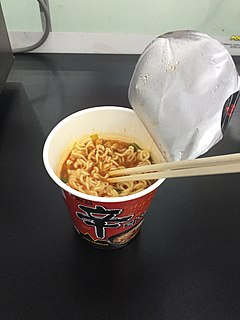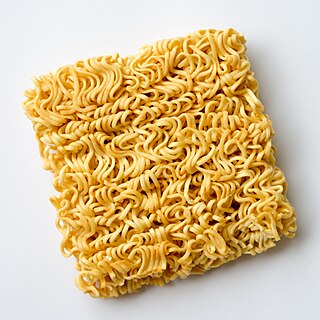 W
WNoodles are a type of food made from unleavened dough which is rolled flat and cut, stretched or extruded, into long strips or strings. Noodles can be refrigerated for short-term storage or dried and stored for future use.
 W
WAlkaline pasta, or alkaline noodles, is a variation of Chinese or Italian pasta in which a much higher than usual quantity of an alkaline component is part of the fabrication process. This is usually achieved by the introduction of sodium carbonate (Na2CO3 or sodium salt of carbonic acid) into the primary ingredients. In parts of China in which alkaline wheat noodles are common, traditional ones are made with alkaline water from wells. More commonly a mixture of sodium carbonate, which is also an anti-caking agent, and potassium carbonate is added directly. This mixture is what the Chinese call "jian" and what the Japanese call "kansui"; it is best known in the West for the ramen soup noodles from Japan that use it. Sometimes kansui can also be a solution of sodium hydroxide.
 W
WCellophane noodles, or fensi, sometimes called glass noodles, are a type of transparent noodle made from starch and water.
 W
WCup noodles are precooked instant noodles with flavoring powder and/or seasoning sauce sold in a polystyrene, polyethylene, or paper cup. The flavoring can be in a separate packet or loose in the cup. Hot water is the only ingredient that is needed separately. Cooking takes 3-5 minutes. Cup noodles have been consumed in Asia for many years. It has started to arise worldwide and it has made them a popular staple around the world.
 W
WEgg barley or egg drops, called tarhonya in Hungarian or tarhoňa in Slovak, is an egg-based pasta, often found in Hungary and Central Europe.
 W
WInstant noodles, or instant ramen, are noodles sold in a precooked and dried block with flavoring powder and/or seasoning oil. The flavoring is usually in a separate packet, although in the case of cup noodle, the flavoring is often loose in the cup. Some instant noodle products are seal packed; these can be reheated or eaten straight from the packet/container. Dried noodle blocks are designed to be cooked or soaked in boiling water before eating but can be consumed dry.
 W
WKesme or erişte is a type of egg noodle found in various Turkic cuisines, including Kyrgyz and Kazakh cuisine. It is also found in Turkish cuisine and is called erişte and “kesme” in modern standard Turkish. The word itself is a nominalisation of the verb to cut or to slice, referring to the slicing of the dough involved in preparing the noodles. The term may refer to the noodles themselves, or the prepared dish made with them. Kesme is traditionally a homemade dish, and not often found at restaurants or cafés. In Turkey, kesme is also known as "erişte", and eaten generally in winter. It is made from flour, egg, water, salt and milk. These ingredients are worked into a dough, which is rolled out, cut, and dried in the sun or an oven after dried for a day.
 W
WThis is a list of notable noodles. Noodles are a type of staple food made from some type of unleavened dough which is rolled flat and cut into long strips or strings. Noodles are usually cooked in boiling water, sometimes with cooking oil or salt added. They are often pan-fried or deep-fried. Noodles are often served with an accompanying sauce or in a soup. Noodles can be refrigerated for short-term storage, or dried and stored for future use.
 W
WMohnnudeln, is the name of thick noodles of a potato dough in Bohemian and Austrian cuisine, similar to the Schupfnudel. The main difference is, that Mohnnudeln are served with melted butter, ground poppy seeds, and sprinkled with confectioner's sugar.
 W
WRice noodles, or simply rice noodle, are noodles made from rice. The principal ingredients are rice flour and water. Sometimes ingredients such as tapioca or corn starch are added in order to improve the transparency or increase the gelatinous and chewy texture of the noodles. Rice noodles are most common in the cuisines of East, Southeast Asia and South Asia. They are available fresh, frozen, or dried, in various shapes, thicknesses and textures. Fresh noodles are also highly perishable; their shelf life may be just several days.
 W
WRice vermicelli are a thin form of rice noodles. They are sometimes referred to as rice noodles or rice sticks, but they should not be confused with cellophane noodles, a different Asian type of vermicelli made from mung bean starch or rice starch rather than rice grains itself.
 W
WSchupfnudel, also called Fingernudel, is a type of dumpling or thick noodle in southern German and Austrian cuisine. It is similar to the Central European kopytka. They take various forms and can be referred to with a variety of names in different regions. They are usually made from rye or wheat flour and egg. Since the introduction of the potato to Germany in the seventeenth century, Schupfnudeln have also been made with potatoes. They are traditionally given their distinctive ovoid shape through hand-shaping. They are often served as a savory dish with sauerkraut but are also served in sweet dishes.